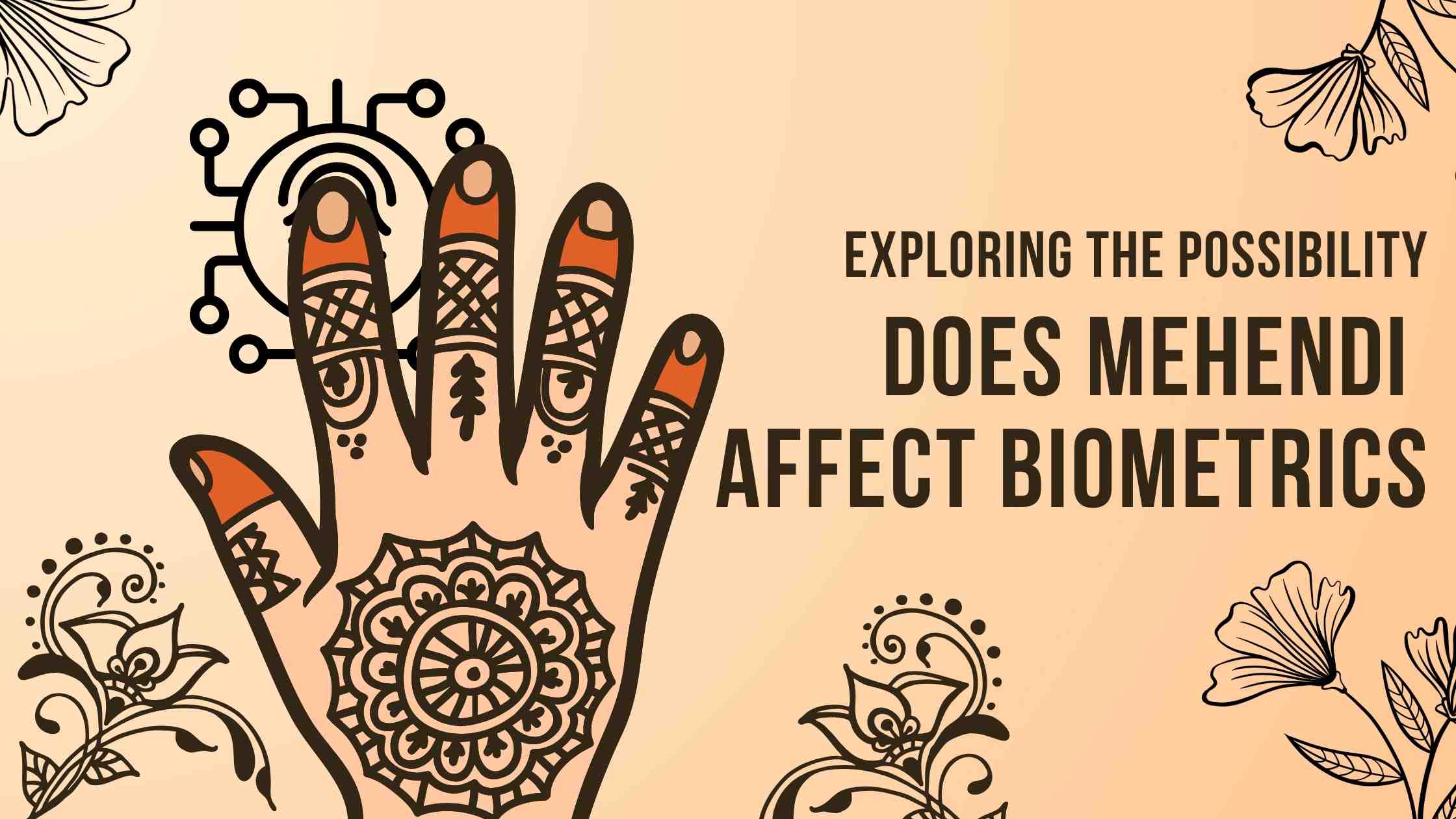Table of Contents
How does mehendi affect biometrics?
Mehendi, also known as henna, is a temporary body decoration that is widely popular in many cultures. When it comes to biometrics, specifically the recording of fingerprints, some concerns may arise regarding the potential interference caused by mehendi.
The biometric scanner used for finger prints collection relies on capturing physical characteristics and the unique ridges and patterns on a person’s fingertips. It is understandable to question if mehendi could obstruct the accurate recording of fingerprints. However, it is important to note that mehendi generally does not significantly affect biometrics.
The dyes used in mehendi typically do not enter deep into the skin, and they usually form a layer on the outermost layer of the skin. As a result, the texture and pattern of the fingerprints remain largely unaffected. The biometric scanner can still sometimes capture the necessary details for identification and verification purposes.
Remembering that mehendi is considered a temporary body decoration is important. Over time, it naturally fades away, which means any potential interference it may cause will also diminish. Therefore, individuals with mehendi on their hands can try to proceed with the digital finger scanners in the biometric process.
Is mehendi a problem for biometric security?
Mehendi, a form of temporary body art created using henna paste, can present challenges for biometric security systems like digital fingerprint scanners and facial recognition software (Digital Photographs). One issue is that the detailed designs of mehendi may temporarily change the texture of fingertips, potentially impacting the accuracy of fingerprint scans. The pattern variations caused by the henna paste may disrupt the scanner’s ability to capture clear and distinct fingerprint impressions.
In addition, oils, lotions, and hand sanitizers commonly used in daily life can also impact the quality and accuracy of biometric data. These substances can create a shield on the skin’s surface and make it more difficult for the scanner to take clear fingerprints or facial images. Therefore sometimes washing of hands can be beneficial for faster processing. The presence of mehendi on the skin adds an additional layer of complexity to the biometric process.
To mitigate these potential issues, it is advisable to remove any mehendi from the fingertips or facial area before undergoing biometric scanning. This ensures that the scanner can capture accurate and reliable information for identification and verification purposes. It is also recommended to not applying oils, lotions, or hand sanitizers before the biometric process to maintain the quality of the biometric data.
Also Read: The Truth Unveiled: Does Mehndi Cause Period Problems?: Exploring the Possibility: Does Mehendi Affect Biometrics
How can one avoid mehendi if they want to avoid problems with biometrics?
Avoiding mehendi is crucial if you want to prevent any problems with biometrics during visa applications. Failing to remove mehendi properly can negatively impact the accuracy and reliability of fingerprint and facial image scans. Here are some safe and gentle methods to remove mehendi from your skin:
1. Baking Soda and Lemon Paste: Make a paste by mixing equal parts baking soda and lemon juice. Apply the paste on the mehendi design and leave it on for a few minutes for it to take effect. Rinse off with water and gently scrub to remove the henna.
2. Exfoliating Scrub: Use a gentle exfoliating scrub on the mehendi design to gradually fade it away. Be careful not to scrub too hard, as it may irritate the skin.
Remember to be patient when removing mehendi, as it may take a few days for the design to completely fade. By using these methods, you can make sure your biometric data is accurately taken, reducing risks with mehendi in visa application process.
What are the risks of not using mehendi properly?
Not using mehendi properly can pose several risks and consequences for your skin. One of the most common risks is skin irritation, which can occur if the henna paste is left on for too long or if it contains any harsh chemicals or additives. This irritation can manifest as redness, itching, or swelling, and in some cases, it may lead to more severe allergic reactions.
Another potential risk of improper mehendi use is the possibility of burns. This can happen if the henna paste is too hot when applied or if it comes in contact with a heat source during the drying process. Burns can cause pain, blisters, and even scarring in severe cases.
Improper removal of mehendi can also have negative consequences for your skin. Scrubbing or scraping the design off forcefully can lead to skin abrasions, which may increase the risk of infection and scarring. Additionally, harsh or abrasive substances used for henna removal can cause skin discoloration.
Sadaf’s 100% Natural Mehndi cone is a safe alternative to the DIY mehndi paste made at home, which is safer for hands and do not contain and harsh chemicals.
Can mehendi be removed with chemicals or scrubbing?
When it comes to removing mehendi from the skin, there are various methods and techniques that can be employed. One common approach is using chemicals or scrubbing to aid in the removal process.
Chemicals such as hydrogen peroxide or nail polish remover can be applied to the mehendi design to help break down the henna pigment and fade the color. Scrubbing the area with a gentle exfoliating scrub or a loofah can also help remove the mehendi, as it helps slough off the dead skin cells and the henna pigment along with it.
However, it is important to note that both chemical and scrubbing methods come with potential risks and precautions. Chemicals can be harsh on the skin and may cause irritation or dryness. In some cases, they can also lead to discoloration or damage the outer layer of the skin. Similarly, aggressive scrubbing can cause redness, inflammation, or even abrasions on the skin.
If chemicals or scrubbing are not suitable options or if individuals prefer more natural and safer alternatives, they can try other methods. Ultimately, each person’s skin may react differently, so it is always advisable to perform a patch test and consult a dermatologist if any concerns arise.
Is mehndi allowed for Canada visa biometric?

Mehndi, also known as henna, is a traditional form of body art that involves applying a paste made from powdered henna leaves on the skin. In the context of Canada visa biometric, it is unlikely that mehndi would be allowed or required.
Biometric data collection for visa purposes usually involves capturing fingerprints, a photograph, and sometimes an iris scan. These biometric measures are used for identification and verification purposes and are standardized across different countries.
While mehndi may be a cultural or religious practice for some individuals, it may affect the visa biometric data collection process. It is important to check with the specific requirements and guidelines provided by the Canadian visa authorities to ensure compliance with their regulations.
You can also refer to the Official Canadian Visa Application Website for more information.
Also Read: 13+ Quick Fixes: How to Remove Mehendi from Nails at Home: Exploring the Possibility: Does Mehendi Affect Biometrics
Is mehndi allowed for US visa biometric

When it comes to US visa biometric, mehndi is unlikely to be allowed or required. The visa process usually involves capturing fingerprints, taking a photo, and sometimes scanning the iris. These measures are used for identification and verification purposes and are standardized worldwide.
While mehndi may hold cultural or religious significance, it could impact the biometric data collection. To ensure compliance with US visa regulations, it’s crucial to check the specific requirements and guidelines provided by the authorities.
You can also refer to the Official U.S Visa Application Website for more information.
Conclusion
In conclusion, mehndi or henna does have an impact on biometrics, specifically on quality of fingerprint and development. The use of mehndi on hands may affect the accuracy of digital fingerprint scans, resulting in the rejection of the biometric data.
Additionally, other products such as viscous oil, greasy lotion, alcohol-based hand sanitizers, and synthetic mehendi can also have an impact on fingerprint quality. These products can alter the density of oils on the skin, affecting the absorption rate and ultimately leading to variations in the fingerprint pattern.
In terms of the impact on fingerprint patterns, alcohol-based hand sanitizers have been found to have the highest impact, followed by greasy lotions and viscous oil. Synthetic mehendi, while it may not affect fingerprint quality to the same extent, can still lead to variations in the pattern.
It is important for visa applicants to avoid using these products before their Visa Application Centre appointment in order to ensure the quality of their fingerprints and the success of their visa application. Following the guidelines provided by the visa application center regarding the use of permissible products and proper hand hygiene is crucial to avoid any issues or delays.





Comment (1)